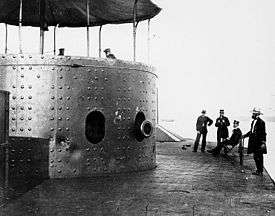Smoothbore

.jpg)

A smoothbore weapon is one that has a barrel without rifling. Smoothbores range from handheld firearms to powerful tank guns and large artillery mortars. The majority of shotguns are smoothbores and the term can be synonymous.
History of firearms and rifling
Early firearms had smooth barrels that fired projectiles without significant spin.[1] To minimize inaccuracy-inducing tumbling during flight their projectiles required stable shape, such as a sphere. However, the Magnus effect causes even spheres rotating randomly during flight to curve when spinning on any axis not parallel to the direction of travel.[2]
Rifling a barrel with spiral grooves or polygonal rifling imparts a stabilizing gyroscopic spin to a projectile that prevents tumbling in flight. Not only does this more than counter Magnus-induced drift, but it allows a longer, heavier round to be fired from the same caliber barrel, increasing both range and power.
In the eighteenth century, the standard infantry arm was the smoothbore musket; although rifled muskets were introduced in the early 18th century and had more power and range, they did not become the norm until the middle of the 19th century, when the Minié ball increased their rate of fire to match that of smoothbores.[3]
Artillery weapons were smoothbore until the middle 19th century, and smoothbores continued in limited use until the 1890s. Early rifled artillery pieces were patented by Joseph Whitworth and William Armstrong in the United Kingdom in 1855. In the United States, rifled small arms and artillery were gradually adopted during the American Civil War. However, heavy coast defense Rodman smoothbores persisted in the US until circa 1900 due to the tendency of the Civil War's heavy Parrott rifles to burst and lack of funding for replacement weapons.
Modern smoothbores
Some smoothbore firearms are still used.
Small arms
A shotgun fires multiple, round shot; firing out of a rifled barrel would impart centrifugal forces that result a doughnut-shaped pattern of shot (with a high projectile density on the periphery, and a low projectile density in the interior). While this may be acceptable at close ranges (some spreader chokes are rifled to produce wide patterns at close range) this is not desirable at longer ranges, where a tight, consistent pattern is required to improve accuracy.[4]
Another smoothbore weapon in use today is the 37-mm riot gun, that fires non-lethal munitions like rubber bullets and teargas at short range at crowds, where a high degree of accuracy is not required.[5]
Artillery
The cannon made the transition from smoothbore firing cannonballs to rifled firing shells in the 19th century. However, to reliably penetrate the thick armor of modern armored vehicles many modern tank guns have moved back to smoothbore. These fire a very long, thin kinetic-energy projectile, too long in relation to its diameter to develop the necessary spin rate through rifling. Instead, kinetic energy rounds are produced as fin-stabililzed darts. Not only does this eliminate the time and expense of rifling barrels it also eliminates the need for replacement due to barrel wear.
The first tank with a smoothbore gun was the Soviet T-62, introduced into service in 1961. Today all main battle tanks field them but the British Challenger 2 and Indian Arjun MBT. While the 73 mm gun of the early Soviet infantry fighting vehicles BMP-1 and BMD-1 was a smoothbore, their more recent successors BMP-3 and BMD-4 use a rifled 100 mm gun. The Russian navy conducted experiments with large-caliber smoothbore naval guns, which were halted by budget cuts.
The armour-piercing gun evolution has also shown up in small arms, particularly the now abandoned U.S. Advanced Combat Rifle (ACR) program. The ACR "rifles" used smoothbore barrels to fire single or multiple flechettes (tiny darts), rather than bullets, per pull of the trigger, to provide long range, flat trajectory, and armor-piercing abilities. Just like kinetic-energy tank rounds, flechettes are too long and thin to be stabilized by rifling and perform best from a smoothbore barrel. The ACR program was abandoned due to reliability problems and poor terminal ballistics.
Mortar barrels are typically muzzle-loading smoothbores. Since mortars fire bombs that are dropped down the barrel and must not be a tight fit, a smooth barrel is essential. The bombs are fin-stabilized.
See also
- Rifling
- Buck and ball
- Cap gun
- Caplock mechanism
- Internal ballistics
- Tubes and primers for ammunition
- Minié ball
- Gunpowder
- Muzzleloader
- Muzzle (firearms)
- Gun barrel
- Projectile
| Look up smoothbore in Wiktionary, the free dictionary. |
References
- ↑ Fadala, Sam (17 November 2006). The Complete Blackpowder Handbook. Iola, Wisconsin: Gun Digest Books. p. 308. ISBN 0-89689-390-1.
- ↑ Forge, John (24 December 2012). Designed to Kill: The Case Against Weapons Research: The Case Against Weapons Research. Springer. pp. 63–64. ISBN 978-94-007-5736-3.
- ↑ Denny, Mark (1 May 2011). Their Arrows Will Darken the Sun: The Evolution and Science of Ballistics. JHU Press. p. 53. ISBN 978-0-8018-9981-2.
- ↑ Haag, Michael G.; Haag, Lucien C. (29 June 2011). Shooting Incident Reconstruction. Academic Press. p. 281. ISBN 978-0-12-382242-0.
- ↑ Kolman, John A. (1 January 2006). Patrol Response to Contemporary Problems: Enhancing Performance of First Responders Through Knowledge and Experience. Charles C Thomas Publisher. p. 102. ISBN 978-0-398-07656-6.
